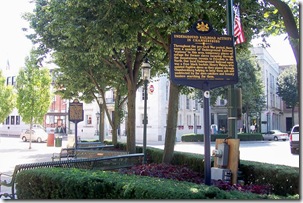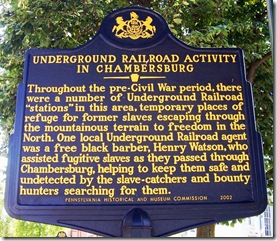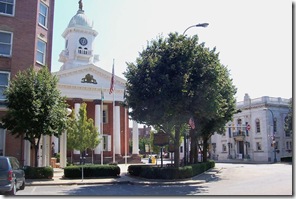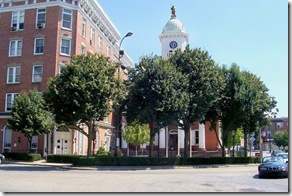Marker Text: Throughout the pre-Civil War period, there were a number of Underground Railroad "stations" in this area, temporary places of refuge for former slaves escaping through the mountainous terrain to freedom in the North. One local Underground Railroad agent was a free black barber, Henry Watson, who assisted fugitive slaves as they passed through Chambersburg, helping to keep them safe and undetected by the slave-catchers and bounty hunters searching for them.
Location: Main St. & U.S. Route 30 (Lincoln Highway), on the Northeast quadrant of the "diamond," in downtown Chambersburg. Erected by the Pennsylvania Historical and Museum Commission in 2002.
Today's marker is one of many historical markers related to the Underground Railroad, as it was to be called. Many communities in Pennsylvania were located just north of the Mason-Dixon line and were natural locations for involvement in the Underground Railroad movement.
 There would probably be hundreds of historical markers about the Underground Railroad in Pennsylvania, if we knew of their existence, therefore no historical markers will ever commemorate their actions. Maintaining records by the people involved about the activities of the Underground Railroad would have been potentially dangerous for the persons helping African-American slaves escape and the escapees themselves, so few records exist. Through later local stories told by residents following the Civil War and the limited number of records that were maintained, we today know about possible routes fugitive slaves would have followed on their journey. What appears clear, however, is that people with widely different backgrounds from across Pennsylvania contributed to the success of the Underground Railroad. They did so at considerable risk, but most remained surprisingly defiant despite the dangers.
There would probably be hundreds of historical markers about the Underground Railroad in Pennsylvania, if we knew of their existence, therefore no historical markers will ever commemorate their actions. Maintaining records by the people involved about the activities of the Underground Railroad would have been potentially dangerous for the persons helping African-American slaves escape and the escapees themselves, so few records exist. Through later local stories told by residents following the Civil War and the limited number of records that were maintained, we today know about possible routes fugitive slaves would have followed on their journey. What appears clear, however, is that people with widely different backgrounds from across Pennsylvania contributed to the success of the Underground Railroad. They did so at considerable risk, but most remained surprisingly defiant despite the dangers.
Until I started to take photos of historical markers and look into the extended history mentioned in the marker, did I realize that every one of the original thirteen colonies, including Pennsylvania, allowed slavery to exist within its borders. Pennsylvania, unlike other colonies, contained a vocal antislavery movement, almost from the beginning of the colony's founding. A small group of German-born Quakers in 1688 issued a stirring statement about the "traffick of men-body" that historians identify as the first protest against slavery in the North American colonies.
Marker in the center of photo, courthouse in the background, the town diamond is located out of the frame to the right. Click any photo to enlarge.
Most wealthy Quakers in seventeenth-century Philadelphia, including William Penn, owned black slaves. Opinion in Pennsylvania slowly changed mainly due to economics. Slavery was less profitable in the north, because the farms were usually smaller. It was also was based on religious faith. The religious protests from Quakers, Methodists, and other denominations grew louder as fear that slavery was increasing at an alarming rate. The increasing existence of a free black population also changed attitudes. The white population realized the contributions made by free blacks to their communities and with the coming of the American Revolution fresh ideas and attitudes about human equality developed.
For many of these reasons, Pennsylvania became the first northern state to adopt an emancipation law. Named the Gradual Emancipation Act, it was passed on March 1, 1780. The end of slavery was not immediate, because the act was gradual, the new rules allowed masters to keep ownership of certain slave children until they were nearly thirty years old. New groups both of whites and freed blacks came into existence to speed up the end of slavery and promote better lives for free blacks. These groups and institutions were important in the history of the Underground Railroad. They helped develop a community of free black residents in Pennsylvania, dedicated not only to each other, but also to African-Americans still in slavery. These groups made possible the creation of a network of stations along the Underground Railroad to help escaping slaves travel through the country side to places where they could finally live free.
The marker is next to the second tree from the left. Several historic markers can be found surrounding the town center.
The Underground Railroad was never as organized as its name implied, but by the 1850s there was a regular network of agents or “stations” in Pennsylvania, like here in Chambersburg. These agents worked together to help care for, transport and relocate fugitives once they arrived within the state's borders. Chambersburg was a natural location for the Underground Railroad since Franklin County bordered Maryland and would have been a place many escaping slaves would have come travelling north particularly along the Shenandoah Valley of Virginia.
Chambersburg was also close to Harper's Ferry where John Brown's raid on the arsenal occurred in 1859. John Brown had been involved in the Underground Railroad in Crawford County, PA where he operated a tannery and later in Ohio and New York. John Brown came to Chambersburg in the summer of 1859 to prepare for his raid. He wore a beard as a disguise and used the alias of Isaac Smith. He took up residence on East King Street in Chambersburg. John Brown had firearms and ammunition delivered to him here in Chambersburg disguised as mining implements. Brown met secretly with Frederick Douglass, notable former slave and abolitionist, in a quarry west of Chambersburg.



No comments:
Post a Comment